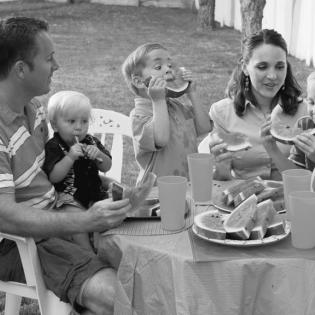Comparing What the World Eats
Participants view pictures of families around the world with the food they eat in a week. Through awareness and discussion, they view cultural and regional differences. They discuss the health, cost, and distribution of food around the world.
The learner will:
- compare and contrast food choices globally.
- explain how their healthy choices are related to availability, economics, and culture.
- a copy of the book Hungry Planet by Peter Menzel and Faith D'Alusio or do an Internet search to find photos or a video of "What the World Eats" + Hungry Planet [https://www.youtube.com/watch?v=VvhLm4eg0ZA]
- undernourished: not having enough food to maintain health and growth
- subsistence: just enough to stay alive
- over-consumption: overuse of goods that results in poorer health of the original organism, i.e., a diet high in fat, sugar, salt
- processed food: food that has been chemically altered through additives such as flavor enhancers, binders, colors, fillers, preservatives, stabilizers, and emulsifiers; food altered from its natural state
- packaged foods: foods packaged outside of the home (often purchased in a box, bag, or can)
Menzel, Peter, and Faith D'Alusio. Hungry Planet. Publisher: Material World (September 1, 2007) ISBN-10: 0984074422, ISBN-13: 978-0984074426
Instructions
Anticipatory Set:
Talk about favorite foods they eat that represent their cultural heritage (this may be everyday foods or traditional holiday foods). Have them propose what makes the food suited to the culture or region of origin.
Remind the group of the three factors that influence access to food and food choice: culture and personal tastes, local availability, and economic resources. Check for understanding by asking: “How does culture—who we are with, family, ethnicity—influence food choices? How does local access and availability influence food choices? How do economic resources influence food choices?”
"Just as the foods that each of us eat are different, access to food and food choices around the world vary as well. We’re going to compare and contrast what people around the world eat in a week, thinking about their cultures and local and economic resources.” Show them the images of What the world eats + Hungry Planet. Tell them these are just samples, and this is not what all people eat in these countries (to avoid developing stereotypes). There are videos and images online. It may be helpful to watch the video and view the images several times and talk about the differences and interesting details. Emphasize the importance of respect and being open to things that are different without judgment.
Discuss:
- How do culture, personal taste, economics, and availability affect food choices?
- What foods are natural and what foods are processed?
- What are some differences? What are some things that are the same? What healthy choices do you see in each family diet?
- How does your attitude about others’ food affect your openness to other cultures?
Reflect on the foods in the different family photos that travel by truck or ship. What is the advantage of eating local food for health and economics? What is the impact on the environment of food that travels farther?
Although there is enough food grown and transported in the world, it is not distributed evenly. Reflect in writing on the following: What responsibility do we have to make food choices that impact other people, locally and globally? Discuss what comes up in their reflections.
Philanthropy Framework
-
Strand PHIL.II Philanthropy and Civil Society
-
Standard PCS 01. Self, citizenship, and society
-
Benchmark MS.2 Discuss why some animals and humans will sacrifice for the benefit of unknown others.
-
-
-
Strand PHIL.III Philanthropy and the Individual
-
Standard PI 01. Reasons for Individual Philanthropy
-
Benchmark MS.5 Describe the responsibility students have to act in the civil society sector to improve the common good.
-
-
